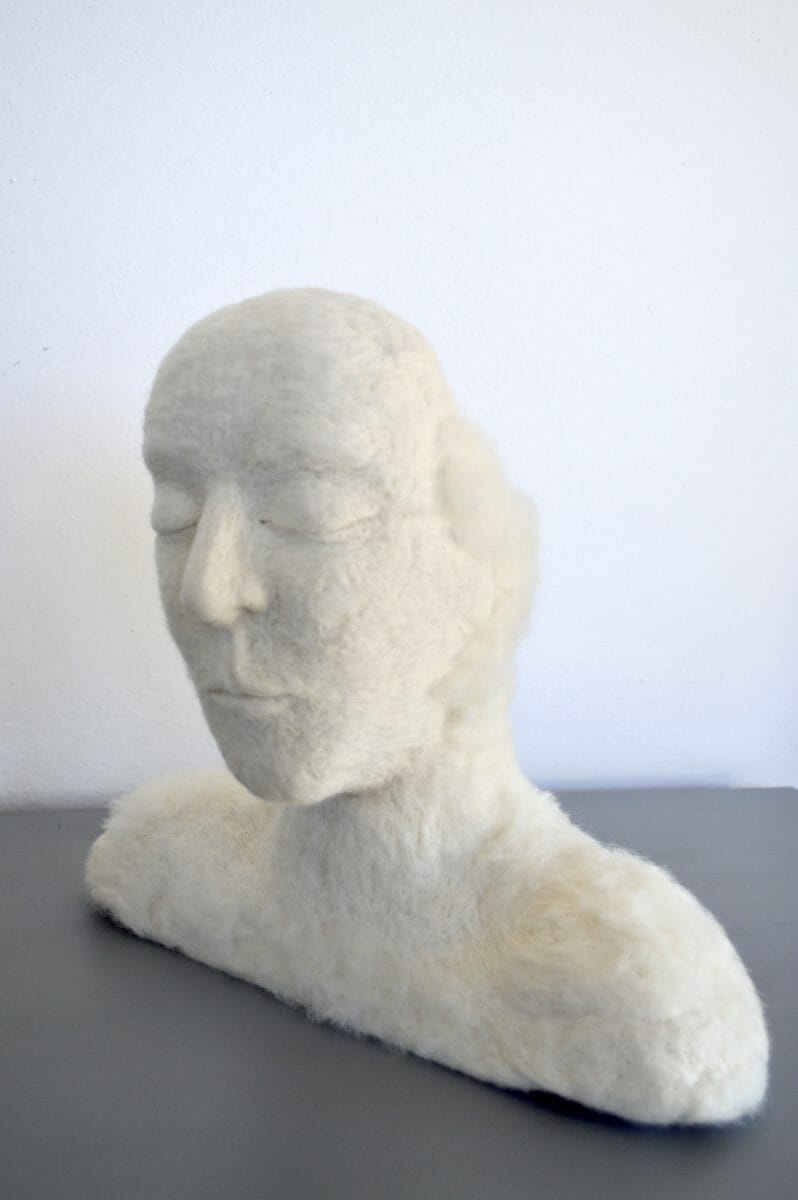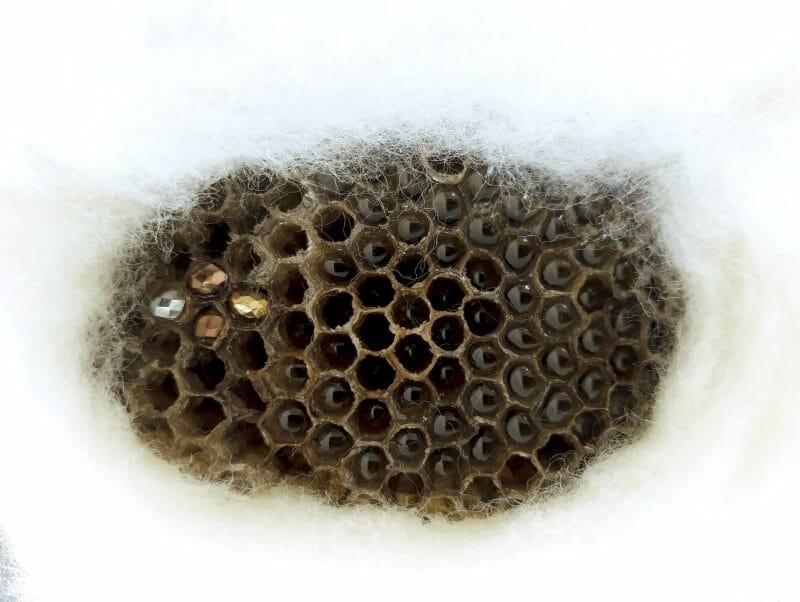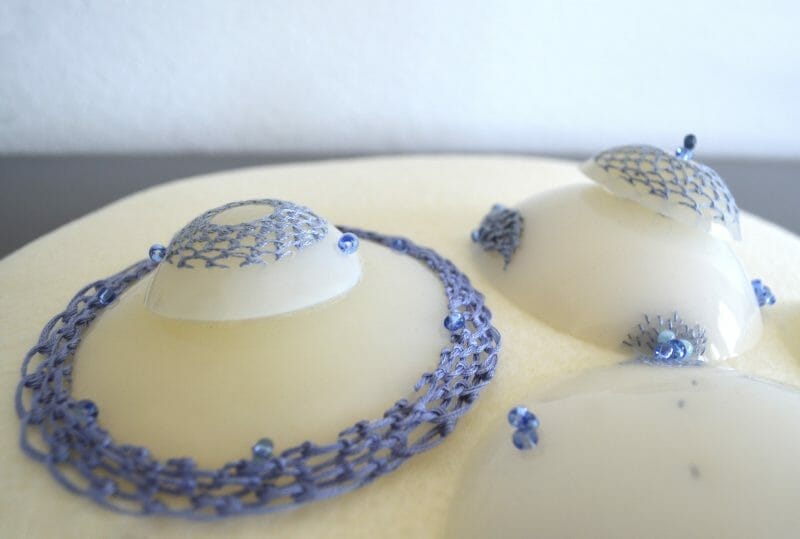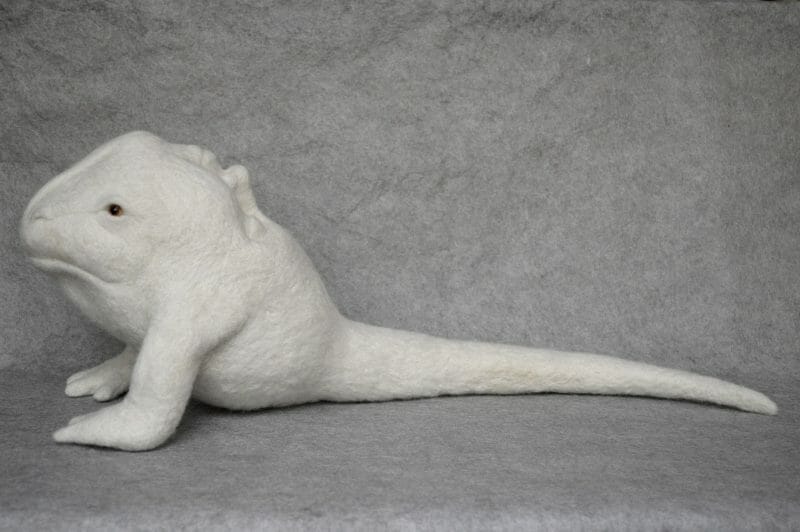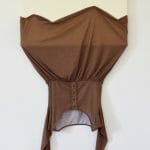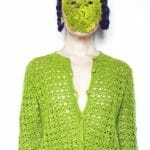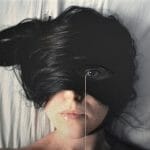ISOBEL BLANK
*Featured photo: Relief, sculpture in needle felted wool, cm 28X20X8 – 2022, courtesy of Gilda Contemporary Art, Milan
Multimedia artist, Isobel Blank was born in Pietrasanta (Lucca) and graduated in aesthetic philosophy at the University of Padua, then completing her training in various disciplines such as theatre, dance, drawing, sculpture, music, photography, which in addition to being present in a fusion of performance art and video, follow their own independent development in parallel.
Her long journey of in-depth study of textile art developed from embroidery to wool processing has led her stylistic research to investigate various aspects of applied art, addressed in particular to design in the field of fashion, textile jewels and toys ‘art.
Her works have been exhibited in galleries, contemporary art museums and international festivals in Italy, the United States, Cambodia, India, Mexico. Selected for Fiberart International in Pittsburgh (USA), she has exhibited – among others – at the Modern Art Museum in Moscow, at the Belgian Academy in Rome, at Palazzo Widmann in Venice, at the Mumbai Art Room in India. She has received numerous awards, including the First Prize for Video Art at the RomaEuropa Webfactory in Rome in 2009.
On the occasion of her recent participation in the Salone Italia at the Textile Museum of Busto Arsizio between the celebratory events of the twenty-fifth anniversary of WTA World Textile Art and her latest solo exhibition set up at the Gilda Contemporary Art in Milan, Blank told us about her research in this exclusive interview for ArteMorbida.

From the plurality of languages passing through a multiplicity of techniques and materials up to the indefiniteness of the forms of your works always halfway between a metamorphosis in progress and a mutating hybrid, your research not only escapes any classification but makes the definition of limit and boundary between the different elements of your somewhat slippery artistic practice. How are your works born? And what is the meaning of this open identity perimeter?
My works are almost never born in the same way, the variety and irregularity also concerns the aspect of genesis. However, it is certainly possible to find some common or recurring traits in the methodology. Intuition, understood as immediate content that manifests itself mentally, is almost always the spark that stimulates the creative process. It is what usually underlies the “vision”, the mental image that drives me to then seek the concrete realization of a concept. Intuition comes in the most varied circumstances, from something I see, read, hear, sometimes from something unusual, often from the most common situations of everyday life. After all, what has always attracted me is to look for wonder in the most obvious, simple, everyday things, hence also my love for philosophy which then became the focus of my studies and partly also of work.
That said, the element that for me can play a key role in the genesis of the creative process is music. I am also a musician, but as a listener it acts on me as a trigger capable of unlocking a chain of emotional mechanisms. The image of a collapsing dam is the closest I can think of to describe it. Music “moves” me physically and metaphorically, it allows me to range, explore deeply the maze of pre-visions, the suggestions that will then lead me to create something. When I first became aware of it, I realized that for me the creative process can also be self-induced.
The fact that defining or outlining a perimeter for the multiformity of my work turns out to be an unfortunate task, first put me in difficulty, even in the simple need to relate to what has always come naturally for me to do, or in having to explain it to whoever is around me. With the consciousness that has come a posteriori, I can say that my inclination to indulge in becoming is probably more natural than one might think, and that aspiring to a single form may actually be the intention furthest from our nature. This expression probably derives from the influence that the study of oriental aesthetics has had on my research. If one thinks of any of the innumerable traditional paintings of oriental landscapes that they would have happened to observe, two of the elements that are almost always present are the mountain (shan, yang quality, white, masculine, rigid) and water (shui, yin quality, flexible, mobile, dark, feminine). The balance between the spaces reserved for the mountains and those for the waters, the way in which mountains/stones and water/streams are arranged, always expresses itself as an asymmetrical equilibrium, and it is precisely the irregularity of the spaces that confers calm, stillness, harmony, since it is what we observe in reality.
I am fascinated by the becoming, the polymorphic, the unfinished, the partiality. Thinking by its nature is always perspective, changeable, and implies movement. The stasis of solidity is alienating, it is an illusion of apparently comforting stillness that comes to us from what appears to us as stable, but which then turns out to be unreal. To conclude, each representation will still be incapable of describing reality in its entirety, it may at most be evidence of its absence, therefore it will still be incomplete.
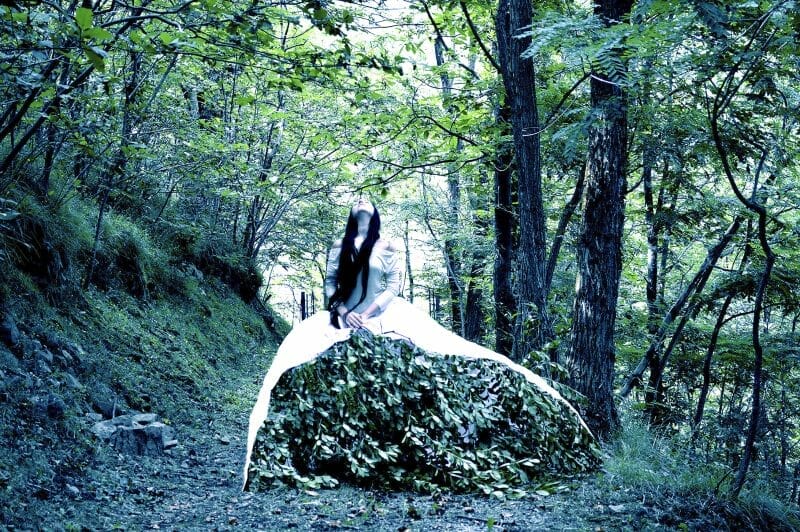
What is the role and importance of experimenting with techniques and materials in your artistic research?
The search for materials and techniques is one of the most stimulating aspects of my work for me. The moment I have a clear idea and have sketched out a project for the creation of a work or a series of works, the study of what the material could be and consequently the most suitable technique for the most exhaustive realization follows. Each work speaks a different language and needs its own specific terms. I start with insights, parallel research on several fronts, and then move on to the first practical tests. In doing so, I also have to consider the most trivial aspects, starting with the means I have at my disposal, those that I can get hold of, the simplest and most essential methods, the space necessary for the creation of the works, and subsequently for any archiving of the works themselves, in short, a set of elements that can give me as complete a picture as possible of what I am preparing to create. I have studied and deepened many different disciplines over the years, but the fact that I can often approach completely new techniques to experiment for the first time, autonomously and starting from scratch, and that I must be able to reach a high quality in a very short time, it is a factor that allows me to continuously evolve and consequently I find it quite exciting.It is an experience that I closely resemble when as a child I took my book on “100&100 crafts for children” and then set off in search of the objects we had at home to be able to make the toy of the day, whether they were ladles, rice, jars of yogurt or fabrics, cards and glue, it was one of my favorite activities to engage in when I was very little and which probably influenced me the most in my subsequent choices and habits.
Does the textile medium also have an intrinsic meaning for you linked to memory and identity as well as the technical and functional characteristics suitable for your artistic practice?
The needle felting technique of wool, with which I create sculptural works, is an ancient, traditional and tiring technique, which has been somewhat lost over time, and which I approached by chance, in a completely self-taught way. The fiber, the embroidery thread, the simple thread of any type and origin, however, have always been present in my life in various forms. Both my grandmothers sewed by hand and machine, embroidered or worked wool and crochet to create clothes and more, sometimes even toys. My mom has always worked with wool and cotton and made clothes for the whole family, and I probably owe my dad the aptitude for research, which in his case he has always applied in the chemical/industrial field, while I in the artistic field. As a chemical researcher, especially in the fiber sector, he has always brought home new experiments, inventions, patents, ranging from plastic chips made from recycled bottles to make fibers, up to fluorescent wadding or carbon fiber for warming fabrics. He has traveled the world in search of the most innovative materials and has developed original ones, and this has always involved and fascinated me, in one way or another.I believe that in a certain sense the role that hair has assumed in my works, if I think of it as bodily threads, is also connected to memory and identity. Biologically speaking, they are the memory of the body, just think of the trichological analyzes and their ability to store chemical information concerning the body even for many months, in addition to the fact that their life cycle lasts several years. For me they have always represented a reservoir of unusual scenarios, I have used them in the most disparate ways, from stop-motion in video-art works, to simple scenic elements in much of my photographic production.

Nature is a widespread presence not only in the formal code of your works but also in their very substance: in the use of fibers – be they of vegetable or animal origin – as well as bioplastics, in the integration of natural elements in your works – the beehives, for example. What is the relationship between you, your art and nature?
Nature is the ineliminable background which at the same time also participates in the individual, in the figure who acts against that background. In my particular case I have always had a strong bond with the natural elements, which I experience as a fundamental substrate. They have remained almost the only constant in all the travels, transfers and homes I have lived in, first with my family for my father’s work and then independently, as a modus vivendi that I can’t do without now. I’ve always been attracted by minimal factors, small details, mosses, lichens, stones, foliage, the veins of the bark, the paths of insects. I have always found comfort in the silent observation of plants, of their apparent fruitful immobility, which makes even the simple blending of one color into another pure epic. It seems to me that in comparison, man thrashes so disjointedly and loudly, failing even the slightest to reach the same silent wonder of an evolving tree canopy, sometimes for a whole century or more, standing still in the same place. This probably explains the fact that I use many natural elements in my works, sewing moss together with wool, shaping leaves to create imaginary scenarios, immersing myself in wooded backgrounds for videos and photographs or combining real beehives with felted wool in my sculptures or installations. In short, I find my family dimension in nature, wherever I am, even when I am physically or emotionally far away.
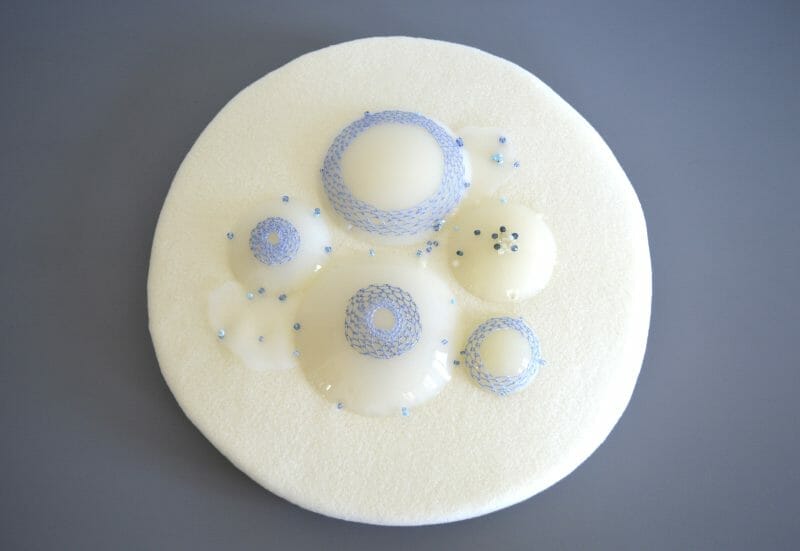
What does it mean to be an artist? And what does ‘Art’ mean to you?
I believe that being an artist is not a choice, there are those who speak of vocation, of necessity or requirement, I would add: humble spontaneous movement, or at least that’s how I feel it. It is undoubtedly the only way I could define myself, I don’t see many alternatives to describe what I do, other than making a long and approximate list of various disciplines and applications of the same, which sometimes mix or overlap and which in any case it would not be exhaustive. It might seem high-sounding, opinionated or inconclusive,but I would answer that it is a definition like any other, and that perhaps in some cases there is a need to clarify the use of the term. For me personally, being an artist means being a filter, but it’s my way of living it. I like to think of myself as a membrane that filters reality and makes it surreal, in an osmotic mechanism that starts from small, minimal, natural or domestic things and which, in continuous exchange, tries to translate them into something universal.
But I experience it as a process that will never be completed, as if in the very tension towards that end, an intermittent and partial emergence of the meaning of life were expressed, without that meaning ever being completely clear. After all, it is precisely by digging into the darkness of the poetry that permeates what surrounds us, that it sometimes seems to be able to see fragments of truth, epiphanies of reality. In this continuous and imperfect action, the very incipit of that tension of which I was speaking earlier should reside.
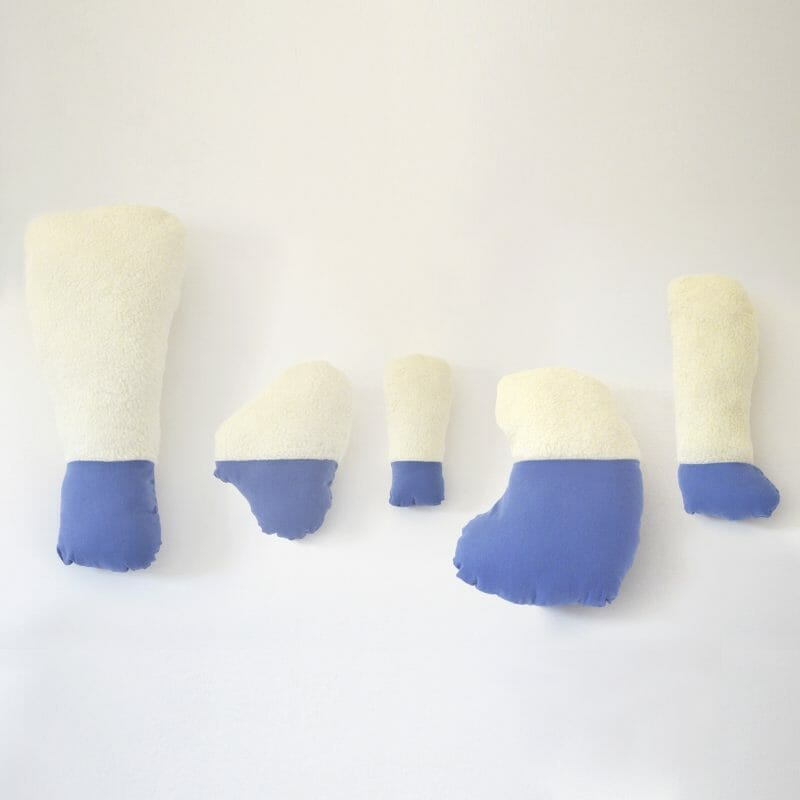
Who – or what – and how has most influenced or inspired your artistic career?
I would try to make a list of all the important influences I’ve had in the most diverse fields, from literature, philosophy, dance, theatre, cinematography, illustration, comics, photography, visual art, music, the time and probably the space available would not be enough for me.I could not choose one over the others, because it was the whole that, over time, adding up to my experiences, formed that magma from which my ideas and probably my style emerge. In general, if I had to put something in particular on the pedestal, in a scale of influences, I would choose not a character, but an attitude: the extreme seriousness that characterizes the dimension of the game. This is the element that above all I keep as one of the most precious things and that I hope never to abandon. That set of autosuggestion, will and need for transfiguration and identification, which make it possible to feed on stories endlessly, without ever being satisfied. The insatiability of stories to live and imagine is something we should all suffer from, in order to develop and cultivate empathy, one of the most important attitudes for coexisting harmoniously.
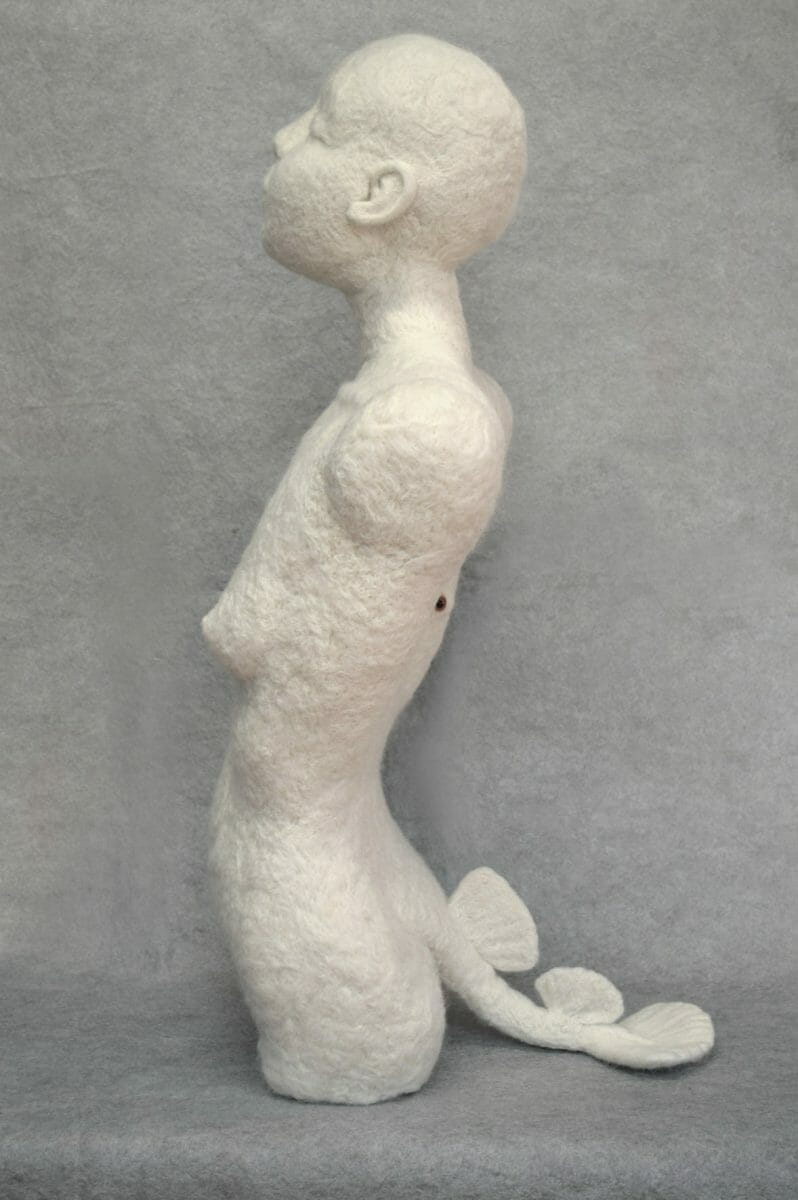
How has your research evolved over time and what is the next horizon towards which you are headed?
I’m not very good at adding up, maybe more at noting subtractions. I like puns and in this case what I say actually has a meaning. Looking back and looking at my creative production, I can certainly say that there has naturally been an evolution and I can try to draw some strings in the themes, style and forms in which my thought has crystallized from time to time. But I think in all of this really what I should notice are the empty spaces. Emptiness is the space necessary for everything to exist, just as geometric space is the condition for the emergence of a line, point, surface and as silence is necessary for the emergence of words and sound. Perhaps in the disposition and dynamics that the void and the sign, the full, have taken on in my works, perhaps there one can find the most significant common thread. I believe that over the years I have carried out a chiselling action, a metaphorical chisel, a reduction to the essentials, and that this operation is still in progress, and will have no end. On the contrary, it seems to me that it is reunited at the beginning, as in an evanescent ouroboros. In the first years in which I found myself exhibiting what I created, I made very slender resin sculptures which, articulating themselves into sinuous forms, seemed to stretch out to infinity and be reduced to a thin line.The last one-man show I have assembled, HORIZONS, speaks exclusively of line, that of the horizon in fact, which I have tried to dissect and represent through textile lucubrations of different types. I used fabrics, my clothes, I sewed, padded and needle felted wool. Staying on the subject of new materials and new techniques, I embroidered the silicone through the use of pliers, decorating with threads, agate and glass beads, some silicone modules shaped by me, to create new horizons: soft circular scenarios halfway between possible biological evolutions, future cellular landscapes and idyllic profiles of rubbery reliefs, in which to feel once again at the center of one’s own space. In short, it seems that the track must continually explode and reconfigure itself in countless daring evolutions, to then return to itself anyway. Overall, it seems to me that I have begun and continued along this path of reduction to the essence, and I believe that I will continue to act on this “line” or thread in the future as well.


